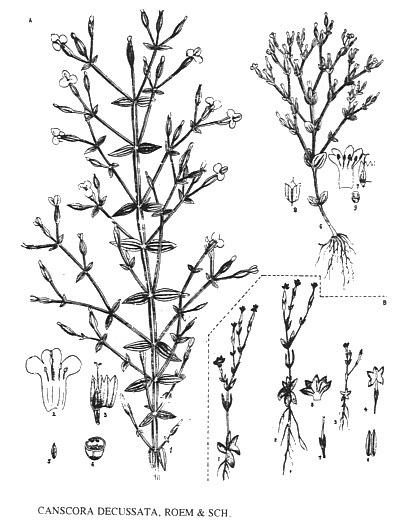

Zitierweise / cite as:
Carakasaṃhitā: Ausgewählte Texte aus der Carakasaṃhitā / übersetzt und erläutert von Alois Payer <1944 - >. -- Anhang A: Pflanzenbeschreibungen. -- Canscora decussata Roem. et Sch. -- Fassung vom 2007-03-19. -- URL: http://www.payer.de/ayurveda/pflanzen/canscora_decussata.htm
Erstmals publiziert: 2007-03-19
Überarbeitungen:
Anlass: Lehrveranstaltung SS 2007
©opyright: Dieser Text steht der Allgemeinheit zur Verfügung. Eine Verwertung in Publikationen, die über übliche Zitate hinausgeht, bedarf der ausdrücklichen Genehmigung des Verfassers
Dieser Text ist Teil der Abteilung Sanskrit von Tüpfli's Global Village Library
WARNUNG: dies ist der Versuch einer
Übersetzung und Interpretation eines altindischen Textes. Es ist keine
medizinische Anleitung. Vor dem Gebrauch aller hier genannten Heilmittel wird
darum ausdrücklich gewarnt. Nur ein erfahrener, gut ausgebildeter ayurvedischer
Arzt kann Verschreibungen und Behandlungen machen!
Falls Sie die diakritischen Zeichen nicht dargestellt bekommen, installieren Sie eine Schrift mit Diakritika wie z.B. Tahoma.
Verwendete und zitierte Werke siehe: http://www.payer.de/ayurveda/caraka0001.htm

Abb.: Canscora decussata Roem. et Sch.
[Bildquelle: Kirtikar-Basu, ©1918]
Dutt:
"CANSCORA DECUSSATA, R. et Sch. Syn. Platera decussata, Roxb.
Sans. śaṅkhapuṣpī
Vern. Dānkuni, Beng. Sankhāhuli, Hind.
This little plant is regarded as laxative, alterative and tonic and is much praised as a nervine. It is used in insanity, epilepsy and nervous debility. The fresh juice of the plant, in doses of about an ounce, is given, with the addition of honey and pāchak root, in all sorts of insanity. A paste made of the entire plant, including roots and flowers, is recommended to be taken with milk as a nervine and alterative tonic. The following compound powder is used in similar cases. Take of gulancha, Achyranthes aspera (apāmārga ), bāberang, pāchak root, root of Asparagus racemosus ( satamuli), Acorus Calamus ( vachā ), chebulic myrobalan, and Canscora decussata, in equal parts; powder and mix. It is said that the use of this powder for three days will enable a student to learn by rote a thousand couplets of poetry."
[Quelle: Dutt, Uday Chand: The materia medica of the Hindus / Uday Chand Dutt. With a glossary of Indian plants by George King. -- 2. ed. with additions and alterations / by Binod Lall Sen & Ashutosh Sen. -- Calcutta, 1900. - XVIII, 356 S. -- S. 201f.]